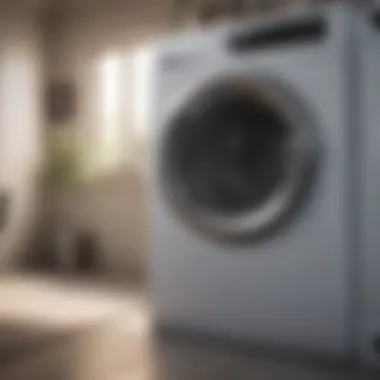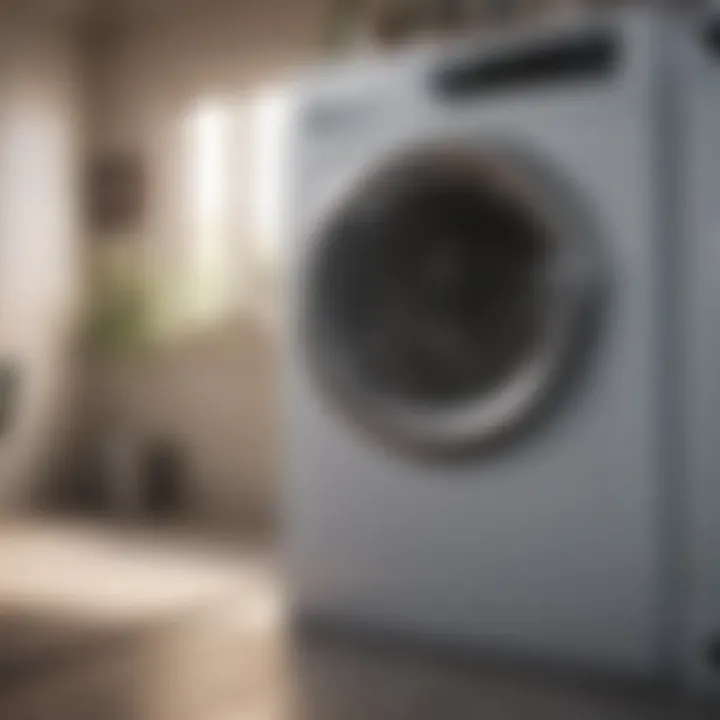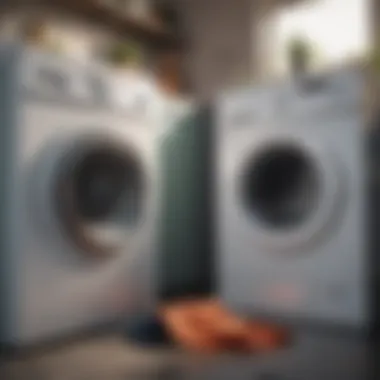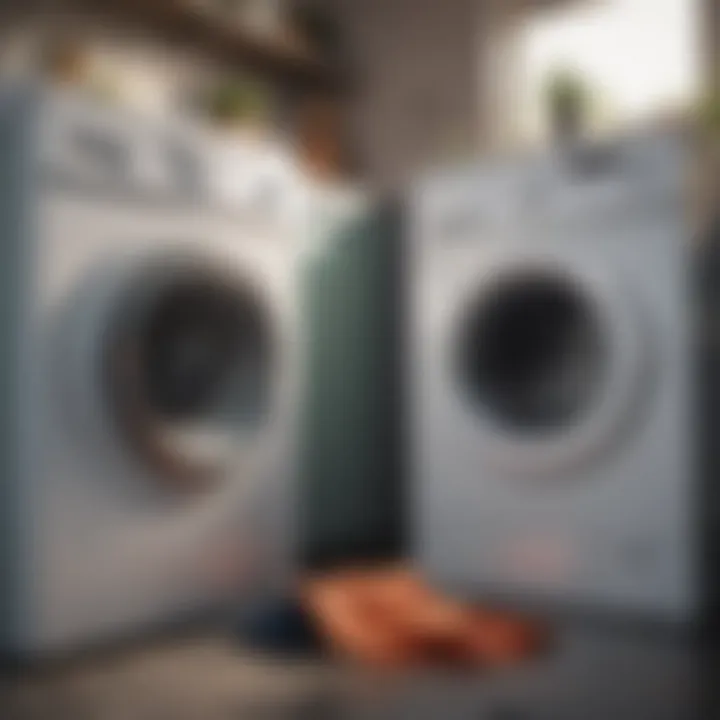A Comprehensive Guide to Cleaning an Electric Dryer


Intro
Cleaning an electric dryer might not seem like a priority, but it can significantly influence both performance and safety. Lint buildup is a common issue among electric dryers, causing inefficiency and potential fire hazards. Understanding how to tackle this task can enhance appliance longevity and reduce energy consumption. In this guide, we present detailed steps for cleaning an electric dryer, including examining various components such as the lint trap, drum, and other essential areas. We will also cover the necessary tools, safety precautions, and the critical role of routine maintenance. This information is vital for homeowners who value efficiency and design enthusiasts who appreciate functional appliances in a well-organized space.
Understanding the Need for Cleaning
In an era where sustainability and efficiency are paramount, regular cleaning of your electric dryer is essential. It's not just about aesthetics; it's about maintaining a fully functioning unit that can save energy and reduce wear. When the lint trap is clogged, the dryer works harder, increasing electricity usage and potentially shortening its life span. Cleaning improves airflow, ensuring that clothes dry thoroughly and quickly. Addressing these issues proactively leads to fewer repairs in the long run.
"A clean dryer operates at optimal performance levels, yielding better results while consuming less energy."
Key Components to Clean
- Lint Trap
This is the most important component to address frequently. The lint trap is designed to capture lint from items during drying, but it can fill quickly. A clogged lint trap is not just inefficient; it's unsafe. - Drum
The drum can accumulate dirt, residue from fabric softeners, and lint. Cleaning it preserves the integrity of the drum and ensures that your clothes come out fresh. - Vent System
The vent system channels hot air out of the dryer. If it’s obstructed, it can lead to overheating and inefficient drying. Regular inspection and cleaning are crucial. - Exterior
It’s also essential to keep the exterior clean. Dust and dirt can gather, affecting aesthetics and health.
Tools Required
To properly clean your electric dryer, you will need a few simple tools:
- Lint brush
- Vacuum cleaner with a hose attachment
- Soft cloth
- Mild detergent (for drum cleaning)
- Screwdriver (for vent access)
Having these tools at hand will streamline the cleaning process, allowing for efficient task completion.
Safety Precautions
Before starting the cleanup, consider these safety tips:
- Unplug the dryer. Always disconnect the appliance from the power source.
- Avoid water near electrical components. Use a damp cloth but do not soak any parts.
- Wear a dust mask. Lint can irritate your respiratory system.
By adhering to these precautions, you ensure a safe and productive cleaning experience.
Epilogue
A thorough understanding of how to clean an electric dryer enables effective maintenance that significantly enhances performance. Keeping essential components clean not only prolongs the life of the dryer but also contributes to overall household safety and efficiency. Regular maintenance can seem tedious, but the long-term benefits—energy savings and a well-functioning household appliance—are worthwhile.
Understanding the Importance of Dryer Cleaning
Cleaning an electric dryer is not just a matter of aesthetics; it plays a crucial role in the appliance’s effectiveness and safety. Regular maintenance enhances efficiency, mitigates potential hazards, and extends the lifespan of your dryer. Ignoring this aspect can lead to significant issues that could have easily been avoided.
Impact on Efficiency
An electric dryer with accumulated lint and debris often has to work harder to dry clothes. Lint buildup in the trap and vent lines restricts airflow, reducing the machine's efficiency. When airflow is compromised, it results in longer drying times. This inefficiency can lead to increased electricity bills and frustrate users. By maintaining a clean dryer, you ensure that it operates at optimal performance levels. Regular cleaning not only saves energy but also helps you avoid inconveniences.
Preventing Fire Hazards
Dryers are one of the leading causes of household fires, and much of this risk is linked to lint buildup. According to the National Fire Protection Association, failure to clean the lint filter is a major factor in dryer fires. The accumulation of lint in the venting system can easily ignite and lead to catastrophic outcomes. By cleaning your dryer thoroughly, you reduce this risk significantly. Maintaining the lint trap and inspecting the vent can save lives and property. Though cleaning may seem tedious, it is a minor effort compared to the potential consequences.
Extending Appliance Lifespan
Just like any other machine, an electric dryer requires care to function efficiently over time. Dirt, lint, and grime can cause wear and tear on internal components. When parts become dirty, they have to work harder, leading to premature failure. Regularly cleaning external and internal components can help in keeping the dryer in good working condition. By taking simple steps to clean and maintain your dryer, you can help prolong its lifespan, ensuring that you get the most value from the appliance.
Regular cleaning can enhance the lifespan of an electric dryer significantly while also improving its performance.


Required Tools and Materials
Cleaning an electric dryer involves understanding the importance of having the right tools and materials. The process can be quite straightforward if you are well-prepared. Using appropriate tools not only increases the effectiveness of the cleaning but also ensures safety and efficiency. This section outlines the essential items that will help you perform the task correctly and efficiently.
Basic Cleaning Supplies
To start the cleaning process, you will need some basic cleaning supplies. These are fundamental for maintaining a hygienic environment within your dryer. Common items include:
- Soft cloths: These are essential for wiping down surfaces without scratching.
- Mild detergent: A gentle detergent can help eliminate grime and odors without damaging components.
- Brush: A soft-bristled brush is useful for removing lint and dust from crevices.
- Baking soda: This is a natural odor neutralizer and can assist in stain removal.
- White vinegar: Vinegar is excellent for breaking down tough stains and also offers antibacterial properties.
Having these supplies on hand will allow you to start the cleaning process efficiently and ensures that your dryer operates optimally.
Safety Gear
Protecting yourself during the cleaning process is crucial. Safety gear helps you avoid potential hazards associated with cleaning an electric appliance. Essential safety equipment includes:
- Gloves: Wearing rubber or latex gloves can protect your hands from harsh cleaning agents.
- Mask: A mask helps you avoid inhaling dust and debris that may accumulate within the dryer.
- Safety glasses: These protect your eyes from any cleaning solution or debris that may get dislodged.
By wearing appropriate safety gear, you reduce the risk of injuries and ensure a safer cleaning environment while safeguarding your health.
Specialized Tools
In addition to basic supplies, using specialized tools can enhance the effectiveness of your cleaning efforts. These tools are specifically designed to address common issues found in electric dryers. Key specialized tools include:
- Lint vacuum attachment: This tool connects to a vacuum hose and helps clear lint buildup from hard-to-reach areas.
- Multi-purpose screwdriver: This is beneficial for removing panels or components that may need deep cleaning.
- Brush for vent cleaning: A long, flexible brush can assist in cleaning out the ductwork effectively.
Investing in these specialized tools can significantly improve your ability to clean the dryer thoroughly, ensuring comprehensive maintenance that enhances performance.
Safety Precautions Before Cleaning
Importance of Safety Precautions
Taking safety precautions before cleaning your electric dryer is a critical step that should never be overlooked. These actions prevent potential injuries and ensure that your appliance is cleaned effectively and safely. Neglecting safety measures can lead to electrical hazards, personal injuries, or even damage to the dryer. A thorough understanding of the necessary precautions is essential for anyone who intends to undertake this cleaning task.
Unplugging the Dryer
The first step in ensuring safety is to unplug the dryer. This simple action eliminates the risk of electrical shock during cleaning. By disconnecting the appliance from the power source, you create a safer working environment. Additionally, it prevents the dryer from accidentally starting while you are cleaning it. Always double-check that the dryer is truly unplugged before proceeding with any cleaning task.
Wearing Protective Equipment
Wearing protective equipment is another crucial safety measure. This equipment may include gloves, masks, and protective eyewear. Gloves protect your hands from dirt, debris, and any harsh cleaning solutions. Masks prevent you from inhaling dust or fumes released during cleaning, particularly from the lint trap and vent. Protective eyewear shields your eyes from dust and any cleaning agents. Ensuring that you are properly equipped minimizes health risks while maximizing comfort during the cleaning process.
Ensuring Ventilation
Ensuring proper ventilation while cleaning is vital. Good airflow helps to dissipate any dust or chemical fumes released during cleaning. Open windows and doors to allow fresh air to circulate the space. If possible, use fans to enhance ventilation. This measure not only protects your health but also improves the efficiency of the cleaning process. If the space is poorly ventilated, harmful particles can accumulate, increasing the risk of respiratory issues.
"Safety first, as an ounce of prevention is worth a pound of cure."
In summary, adhering to safety precautions before cleaning the dryer is fundamental for a successful and secure cleaning experience. These practices not only protect the individual performing the task but also ensure the longevity of the appliance. By following these guidelines—unplugging the dryer, wearing protective equipment, and ensuring ventilation—you pave the way for a comprehensive and safe cleaning process.
Step-by-Step Cleaning Process


Cleaning the electric dryer is a critical maintenance task that ensures the appliance functions properly and lasts longer. This section outlines a methodical approach to cleaning, emphasizing specific actions that can significantly enhance the dryer’s efficiency.
Cleaning the Lint Trap
The lint trap is a vital component that requires regular attention. It collects lint and debris shed from clothes during the drying process. When this trap is not cleaned frequently, it can lead to reduced airflow, causing the dryer to overheat. To clean the lint trap, remove it from its compartment, discard the accumulated lint, and wash it with warm soapy water. Make sure to dry it completely before placing it back. Maintaining a clean lint trap not only improves drying efficiency but also reduces the risk of fire hazards.
Vacuuming the Vent Hose
The vent hose is another critical area that can accumulate lint and debris. If left unattended, blocked ventilation can cause your dryer to work harder, increasing energy consumption and potential overheating. To vacuum the vent hose, disconnect it from the dryer and the wall. Use a vacuum with a long nozzle to reach deep into the hose. This step is essential for maintaining airflow and preventing potential hazards. It is a straightforward task but one that can have a profound impact on the dryer’s operation.
Wiping Down the Drum
The drum of the dryer can collect residues from fabric softeners and other laundry products. Over time, this can build up and contribute to odors. To clean the drum, use a mixture of water and vinegar on a soft cloth. Wipe the drum thoroughly to eliminate any spots, ensuring it is clean for the next load. Regular cleaning of the drum helps maintain a pleasant scent in freshly dried clothes and prevents transfer of odors between loads.
Disinfecting External Components
The external components of the dryer, such as the control panel and door, should not be overlooked. These surfaces can harbor germs and dirt. Using a disinfectant spray or wipes, gently clean all external areas, ensuring you do not get liquid into electronic components. This task is quick but essential for maintaining hygiene in your laundry area. Regular disinfection helps prevent the spread of pathogens and keeps your dryer feeling fresh and clean.
Removing Stains and Odors
Cleanliness is not just about removing lint; it also involves addressing stains and odors that can accumulate in your electric dryer over time. These unwanted elements not only diminish the dryer’s efficiency but also affect the freshness of your laundry. Properly managing stains and odors ensures that your laundry remains clean and may extend the appliance’s life.
Identifying Common Stains
Different materials and substances can lead to stains inside the dryer. Knowing what to look for aids in effective cleaning. Here are some common stains:
- Detergent Residue: Often appears as a grey or white film on the drum. This occurs due to excessive detergent use or improper rinsing during the wash cycle.
- Oil Stains: These can come from items like oily rags or clothing that have been in contact with cooking oils.
- Ink Stains: If a pen leaks or is left in a pocket, ink can leave stubborn stains.
- Food Stains: Clothes that have contacted food can transfer these stains into the dryer drum.
Identifying these stains is the first step in removing them effectively. Inspect the drum regularly to catch stains before they set in.
Effective Odor Removal Techniques
Odors can be particularly troublesome. They often reveal that a build-up of moisture or pungent substances is occurring. Here are effective techniques to combat bad smells:
- Baking Soda Paste: Mix baking soda with water to form a paste. Apply it to areas where stains are found. Let it sit for a while before wiping with a damp cloth.
- Vinegar Solution: White vinegar is an excellent natural deodorizer. Mix one cup of vinegar with one cup of water in a spray bottle. Lightly spray the interior of the dryer drum and wipe it clean with a soft cloth. Avoid excessive soaking to keep moisture levels in check.
- Essential Oils: Adding a few drops of essential oils, like lavender or tea tree oil, to a cotton ball and placing it in the dryer can impart a pleasant scent. Just ensure you do not overload or block the venting.
- Air Drying Baskets: Sometimes simply placing odor-absorbing items like activated charcoal or baking soda in the dryer when not in use can help filter the air. This method requires minimal effort yet can significantly improve overall freshness.
Removing stains and odors not only enhances the user experience but also aligns with best practices in appliance care.
Regularly addressing these issues helps maintain the efficiency of your electric dryer and ensures your clothes come out smelling fresh.
Post-Cleaning Maintenance
Regular maintenance of your electric dryer post-cleaning is essential for efficient operation and long-term appliance health. This section emphasizes the significance of frequent checks and actions that help maintain the dryer’s pristine condition. By keeping up with these tasks, you can avoid unnecessary repairs and extend the appliance's lifespan. Building a post-cleaning routine can be an effective strategy for any homeowner.
Regular Lint Trap Checks
Monitoring the lint trap is a straightforward yet crucial task. After every use, become accustomed to removing lint from the trap. This can prevent lint buildup, improving airflow during the drying cycle and enhancing appliance efficiency. Remember that lint doesn't just accumulate in the trap; it can also collect within the vent system. Regular checks can help you identify and clear any build-up from the trap and beginning of the ducting.
To maintain optimal dryer performance:
- Remove lint after each load.
- Inspect the trap for any tears or damage.
- Occasionally wash the lint trap with soapy water, as residues can sometimes build up over time.


By implementing these simple practices, you help ensure your dryer runs effectively, saving energy and reducing drying times.
Annual Deep Cleaning
Planning an annual deep cleaning is another critical element of post-cleaning maintenance. A thorough cleaning goes beyond the basic steps discussed previously. This is an opportunity to tackle areas often overlooked, such as the inner workings of the dryer and the exterior surfaces.
During this annual deep clean, consider following these guidelines:
- Clean the inside of the drum thoroughly. Use a mild detergent to remove any residues and stains.
- Inspect and clean the venting system. This includes checking for blockages or debris that could hinder airflow.
- Deep clean the exterior. Use appropriate cleaners to remove dust and grime, ensuring that the dryer looks as good as it performs.
Conducting such a deep cleaning once a year can enhance performance significantly, reducing the likelihood of mechanical issues arising from neglect.
Inspecting Ventilation System
The ventilation system is a vital component that should not be neglected. Proper airflow is necessary to ensure your dryer operates effectively and safely. Inadequate ventilation can lead to overheating and potentially hazardous conditions, including fires.
To keep your dryer safe and efficient, you should:
- Conduct regular visual inspections to check for lint accumulation in the vents. If you notice any clogs or restrictions, address them promptly.
- Utilize a professional service for a thorough vent cleaning. While some homeowners might manage basic cleaning, hiring experts can provide peace of mind, especially when venting runs through complex pathways.
- Measure airflow using a simple handheld anemometer to confirm that air circulates as expected. Weak airflow indicates potential issues.
These steps can dramatically reduce risks and maintain the performance of your electric dryer, fostering a safe environment for laundry activities. By incorporating these practices, you will extend the life and efficiency of your appliance.
When to Seek Professional Help
Cleaning an electric dryer is often a straightforward task for many homeowners. However, there are times when DIY efforts might not suffice. Understanding when to seek professional help is crucial. Not only does this ensure safety, but it also prevents further damage to the appliance. If faced with persistent issues or complex cleaning challenges, it is wise to consult a professional technician. This decision can save time and potentially costly repairs.
Signs of Mechanical Issues
Recognizing signs of mechanical issues is vital in determining whether to call an expert. Common indicators include:
- Unusual Noises: If the dryer begins to make strange sounds during operation, such as grinding or squeaking, it may signal a mechanical problem.
- Overheating: Appliances should not become excessively hot. If you notice excessive heat on the outer casing, this could indicate a malfunction.
- Failure to Start: When the dryer does not turn on despite following the proper steps, it may have electrical or mechanical failures that require professional diagnosis.
- Ineffective Drying: If clothes remain damp even after a full cycle, this could indicate a malfunctioning heating element or other problems in the dryer’s mechanics.
If any of these signs are present, it’s important to refrain from further attempts to fix the device without professional guidance.
Complex Cleaning Challenges
Some cleaning tasks may prove to be more complex than they seem. Handling these challenges properly is crucial for maintaining the functionality of the dryer. Situations where professional assistance may be necessary include:
- Internal Obstructions: If lint build-up is extensive or located deep within the dryer, it becomes a safety concern. This can lead to potential fire hazards if not addressed properly.
- Electrical Components: When cleaning involves disassembling electrical parts, the risk of electric shock increases. This necessitates professional skills and knowledge to avoid injury.
- Duct Changes or Repairs: Altering the ductwork or inspecting vent systems can be intricate. Missteps could affect the dryer’s performance. Seeking help from a trained technician in these matters can ensure proper installation and safety compliance.
"The health of appliances is equally about safety and maintaining their efficiency."
Epilogue
Summary of Key Points
Cleaning your electric dryer serves several critical purposes:
- Improves Efficiency: Regular cleaning ensures optimal airflow and performance, allowing your dryer to work effectively, thus saving energy and reducing costs.
- Prevents Fire Hazards: Lint buildup is a primary cause of dryer fires. By keeping the lint trap and vent system clean, you significantly reduce this risk.
- Extends Lifespan: Proper maintenance can prevent mechanical issues, ensuring the dryer lasts longer.
- Enhances Cleanliness: A clean dryer will prevent odors and stains, which can be transferred to freshly laundered clothes.
These points lay the foundation for a disciplined approach to home appliance care.
Encouraging Regular Maintenance
Regular maintenance of your dryer should not be overlooked. By incorporating simple habits into your laundry routine, you mitigate larger issues that often arise from neglect. Here are some recommendations:
- Set a Schedule: Create a cleaning schedule for yourself, ideally every few months, to clean the lint trap, vacuum the vent hose, and wipe down the drum.
- Stay Alert for Issues: Keep an eye on any changes in dryer performance or unusual sounds, which may indicate a need for professional inspection.
- Educate Family Members: Ensure that everyone using the dryer understands the importance of cleaning and maintaining it properly, which can prevent issues before they begin.
Through these practices, both efficiency and safety are enhanced, allowing your electric dryer to function at its best.







